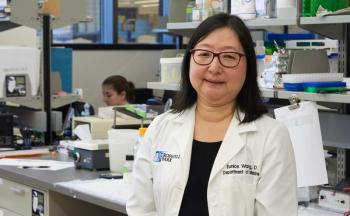
Patients With AML May Acquire TP53 Mutations Over the Course of Therapy
Over the course of treatment, patients with relapsed/refractory acute myeloid leukemia (AML) may acquire new TP53 mutations, making ongoing monitoring for mutations crucial.
Patients with
To understand the clinical implications of TP53 mutations in the emerging therapeutic landscape of AML, researchers evaluated the frequency of the mutations emerging over the course of therapy in patients who relapsed or were refractory to initial treatment. The findings were
“New novel therapies currently in clinical trials are poised to become important strategies for TP53-mutated AML,” the authors wrote. “In this context, detection of TP53 mutations is important in order to select alternative strategies.”
They retrospectively reviewed the records of 1293 patients with newly diagnosed TP53 wild type (WT) AML between December 2012 and March 2020. They identified 200 patients who had relapsed or were refractory to frontline therapy. The median age of these patients was 69 years and nearly half (44%) had normal karyotype.
Other baseline characteristics included:
- Common mutations were SFSF2 (24%), DNMT3A (23%), IDH2 (20%), and NRAS (18%)
- 43% of patients had adverse risk AML, 47% intermediate risk, and 11% favorable risk.
- The majority (66%) received lower-intensity therapy in the frontline
- 11% had undergone prior hematopoietic stem cell transplantation (HSCT) in the first remission
After frontline therapy, 43% were refractory to therapy and 58% relapsed after a median of 6 months.
The researchers found 15% of patients developed a new TP53 mutation during therapy. The majority of those patients (66%) developed the mutation after the first line of therapy, 21% after 2 lines of therapy, and 14% of patients after 3 lines of therapy.
More than half (55%) of patients with new mutations had received frontline intensive chemotherapy. Most patients (83%) had developed 1 TP53 mutation, while 17% acquired 2 mutations. The first detection of TP53 mutation happened a median of 10 months after diagnosis.
Factors associated with an increased likelihood of developing a new TP53 mutation were:
- Baseline chromosome 5 abnormality
- Baseline IDH2 mutations
- Intensive therapy
- HSCT in first remission
Age or other cytogenetic/molecular features were not associated with the development of new TP53 mutations, neither was complex karyotype vs non–complex karyotype at baseline.
After acquiring a mutation, 79% of patients received low-intensity chemotherapy, 7% high-intensity chemotherapy, and 14% no treatment. Most (68%) patients receiving chemotherapy responded, and 7 of those patients underwent HSCT.
The median overall survival after acquiring TP53 mutation was 4.6 months and the 1-year survival rate was just 19%.
“Overall, our findings suggest that sequential monitoring for new, emergent TP53 mutations over the course of AML therapy might have clinical utility,” the authors concluded. “Such monitoring may be particularly relevant in the era of novels therapies with the potential to target TP53-mutated myeloid malignancies.”
Reference
Alwash Y, Khoury JD, Tashakori M, et al. Development of TP53 mutations over the course of therapy for acute myeloid leukemia. Am J Hematol. Published online August 5, 2021. doi:10.1002/ajh.26314
Newsletter
Stay ahead of policy, cost, and value—subscribe to AJMC for expert insights at the intersection of clinical care and health economics.









































